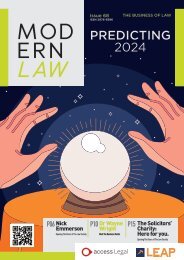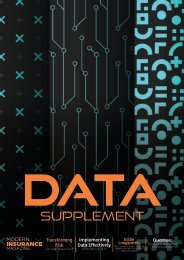Modern Insurance Magazine Issue 65
You also want an ePaper? Increase the reach of your titles
YUMPU automatically turns print PDFs into web optimized ePapers that Google loves.
INSURTECH<br />
Munich Re<br />
Dikla, what are some of 2024’s most exciting emerging<br />
cybersecurity technologies?<br />
Q<br />
In my opinion, 2024’s key trends in cybersecurity are:<br />
A Generative AI, adopted on both sides of the battle.<br />
Generative AI is utilized by both attackers and defenders in<br />
cybersecurity. It fuels an endless race between attackers, who<br />
develop sophisticated cyber security solutions. Attackers use<br />
it to create personalized attacks, such as phishing emails and<br />
deepfake videos, as well as to automate the development of<br />
malware to evade detection. On the other hand, defenders<br />
leverage generative AI for anomaly detection, smart<br />
authentication, automated response, and more.<br />
Social Engineering. There is an expected increase in AIbased<br />
predictive social engineering tactics, combining<br />
AI capabilities with social manipulation techniques.<br />
Cybercriminals exploit human vulnerabilities or nature to<br />
create personalized phishing campaigns at scale, facilitated<br />
by AI.<br />
The Human Touch. Human activities can often serve as<br />
the entry point for a cyber-attack. There is a shift towards<br />
Security Behavior and Culture Programs to address human<br />
risks effectively. Rather than solely focusing on raising<br />
awareness, organizations are now prioritizing behavioral<br />
change to minimize cybersecurity vulnerabilities. By<br />
integrating human-centric security design practices, these<br />
programs aim to reduce friction while maximizing control<br />
adoption.<br />
Third-Party Cybersecurity Risk Management. AI enhances<br />
third-party risk management solutions by analyzing large<br />
datasets to identify potential risks, automating vendor<br />
evaluation processes, and improving incident detection<br />
and response capabilities. By leveraging AI algorithms,<br />
organizations can efficiently assess the cybersecurity posture<br />
of third-party vendors and proactively address vulnerabilities<br />
in their supply chain.<br />
Q<br />
I was intrigued by your recent LinkedIn post regarding the<br />
Hartford Steam Boiler (HSB) by Munich Re’s cyber-in-auto<br />
product announcement. The product provides coverage<br />
for cyber threats related to personal vehicles. Why is this so<br />
important?<br />
As vehicles become more connected through IoT<br />
(Internet of Things) technologies and autonomous<br />
A driving features, the need for robust cyber security<br />
measures has become paramount. Since the car is connected,<br />
we need to secure private information that is stored in<br />
personal vehicles and connected to cloud-based and wireless<br />
communication networks. To an extent, the innovation of<br />
modern cars has increased safety - as seen with information<br />
technology in autonomous vehicles and telematics. Still, they<br />
possess the danger of becoming compromised by attackers.<br />
The pure cyber security technology in place to protect<br />
automotives from cyber-attacks began developing 10 years<br />
ago, and can be leveraged to insurance products.<br />
Q<br />
A<br />
Can you expand on some key takeaways from the recent<br />
cybersecurity panel you took part in at our very own<br />
Insurtech Insights Europe conference, particularly as it<br />
relates to cyber security and personal lines of business?<br />
I was honored to be among the speakers for the topic<br />
‘From Risk to Resilience: Strengthening Cyber Defense<br />
Through User Security’. The focus was on personal<br />
cybersecurity, particularly considering the challenges and<br />
opportunities for personal cyber products.<br />
Many individuals unknowingly share personal data,<br />
highlighting the need for enhanced personal cybersecurity<br />
and awareness. It may sound surprising, but according to<br />
research, the average American provides personal data<br />
to over 1,500 websites a year. Globally however, there’s<br />
limited awareness about individual cyber insurance and its<br />
advantages. It’s a topic that requires the insurance industry<br />
to leverage technology and be very creative. Meaningful<br />
products and solutions can be created to enhance personal<br />
cybersecurity and safeguard online activities and data.<br />
Q<br />
Is AI a friend, foe, or both? Can AI help detect and react to<br />
a breach in real time? Conversely, what is the threat of AI in<br />
the hands of a cybercriminal?<br />
The intersection of cybersecurity and artificial<br />
intelligence is evolving rapidly, with several key areas<br />
A of focus emerging. Firstly, there’s a requirement for<br />
Security for AI developers to shield organizations creating<br />
AI from potential security threats. Simultaneously, ensuring<br />
Security for AI consumers is vital to guarantee the safety of<br />
systems employing AI (organizations are also consumers).<br />
Additionally, tackling Security for AI-driven attacks is<br />
imperative as cybercriminals exploit AI capabilities more<br />
frequently. It is a very dangerous tool in the hands of<br />
criminals. Finally, AI to enhance security presents promising<br />
prospects for fortifying defense mechanisms through the<br />
utilization of AI technologies. Collectively, these domains<br />
delineate a dynamic terrain where the amalgamation of<br />
cybersecurity and AI continually molds digital security.<br />
You’ve had an extraordinary career! Do you have any advice<br />
for young women who may be just starting out in insurance?<br />
Q<br />
This may sound funny, but I would say that when<br />
you are invited to a meeting, always sit at the table,<br />
A both physically and mentally. The first step is to be<br />
physically present, part of the discussion, not in the second<br />
row, not near the table. Sit at the table. The second step,<br />
when you’re ready, is to always speak out and share your<br />
opinion, even if you are not asked to do so. Ask questions,<br />
and be involved. I learned this from a woman I met in my past,<br />
and I 100% believe in it.<br />
Dikla Wagner,<br />
Head of Tech Scouting in Israel,<br />
Munich Re<br />
MODERN INSURANCE | 73
















